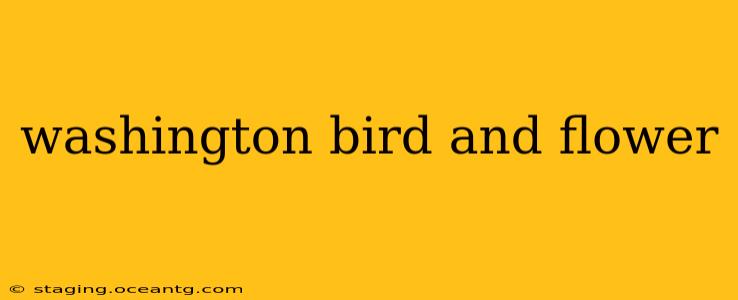Washington state boasts a stunning array of natural beauty, from its majestic mountains to its pristine coastline. But beyond the landscapes, two symbols particularly represent the state's character: the state bird and the state flower. This comprehensive guide delves into the fascinating world of Washington's official avian and floral representatives, exploring their unique characteristics, habitats, and significance to the state's identity.
Washington State Bird: The Willow Goldfinch (Spinus tristis)
The Willow Goldfinch, a vibrant little bird with a cheerful song, was officially designated as Washington's state bird in 1951. Its bright yellow plumage, particularly striking in males during breeding season, makes it a delightful sight in Washington's diverse habitats.
What makes the Willow Goldfinch special?
The Willow Goldfinch is a common sight across the state, inhabiting various ecosystems, from meadows and fields to city parks and gardens. Its adaptability and cheerful presence have resonated with Washingtonians for generations, solidifying its position as a beloved state symbol. Its diet primarily consists of seeds, making it a crucial part of the state's ecosystem. Interestingly, the female goldfinch is less brightly colored than the male, exhibiting more olive-green hues.
Where can I see Willow Goldfinches in Washington?
You have a high chance of spotting Willow Goldfinches throughout Washington, especially during migration seasons. They frequent areas with abundant seed sources, such as sunflowers, thistle, and various weeds. Look for them flitting about in open fields, along roadsides, and even in urban parks and backyards with suitable vegetation.
Washington State Flower: The Coast Rhododendron (Rhododendron macrophyllum)
The Coast Rhododendron, with its large, showy blossoms, has held the title of Washington's state flower since 1890. This magnificent flowering shrub adds splashes of vibrant pink and purple to the state's forests and landscapes, symbolizing the state's natural splendor.
What makes the Coast Rhododendron unique?
The Coast Rhododendron is a truly iconic plant of the Pacific Northwest. Its impressive size, with blossoms sometimes reaching a diameter of eight inches, is a distinctive feature. The flowers' colors vary, ranging from pale pink to deep purple, contributing to the diversity and beauty of the Washington landscape. It's a significant part of the understory of the Pacific Northwest's forests, playing a vital role in the ecosystem.
Where can I find Coast Rhododendrons in Washington?
Coast Rhododendrons thrive in the moist, shaded forests of western Washington. You'll find them abundantly along the coast and in the foothills of the Cascade Mountains. National and state parks offer excellent opportunities for viewing these stunning flowers in their natural habitat.
Frequently Asked Questions (FAQs)
These FAQs are based on common searches related to Washington's state bird and flower.
What other birds are common in Washington state?
Washington boasts an incredible avian diversity. Beyond the Willow Goldfinch, you can spot a wide array of species, including bald eagles, hummingbirds, various woodpeckers, and many migratory birds. The specific birds you encounter will depend on location and season.
When is the best time to see the Coast Rhododendron in bloom?
The Coast Rhododendron's blooming season typically falls between April and June, though the exact timing can vary slightly depending on elevation and weather conditions. Spring is the optimal time to witness these flowers in their full glory.
Are there any conservation efforts for the Willow Goldfinch and Coast Rhododendron?
While both the Willow Goldfinch and the Coast Rhododendron are relatively common, conservation efforts are always ongoing to protect their habitats from threats like deforestation and habitat fragmentation. Supporting organizations dedicated to preserving natural areas in Washington is a great way to contribute to their long-term survival.
Can I grow a Coast Rhododendron in my garden?
Yes, you can! However, success depends on providing the right conditions. Coast Rhododendrons prefer acidic, well-drained soil, ample moisture, and partial shade. Researching the specific needs of the plant is crucial for successful cultivation.
This detailed look at Washington's state bird and flower provides a deeper appreciation for the natural wonders that enrich the state's identity and landscape. From the cheerful song of the Willow Goldfinch to the vibrant blooms of the Coast Rhododendron, these symbols represent the beauty and diversity of Washington state's natural heritage.
